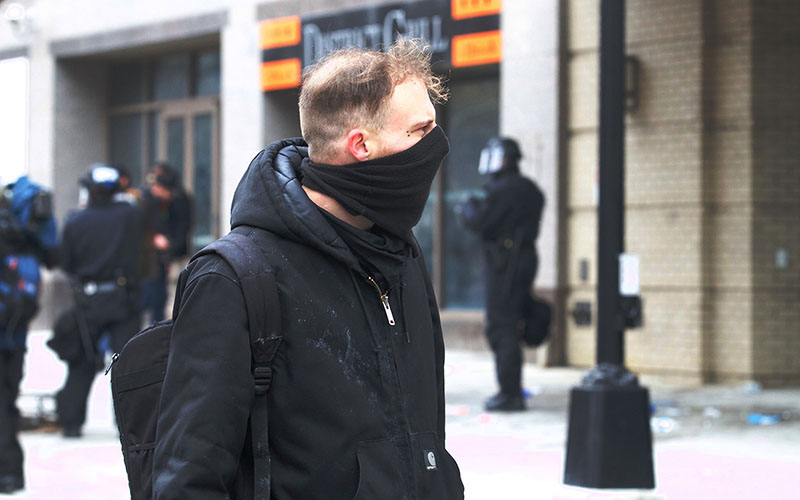
Protesters representing a wide variety of groups and causes came together in Washington to protest the swearing-in of President Donald Trump. (Photo by Dustin Quiroz/Cronkite News)

Pepper spray was just one of the counter-riot measures used by police, who also used tear gas, to stop protesters who police said resorted to vandalism. (Photo by Dustin Quiroz/Cronkite News)

A masked protester in downtown Washington, where the inauguration of President Donald Trump did not appear to have been affected by the demonstrations nearby. (Photo by Dustin Quiroz/Cronkite News)

Police in riot gear move forward against protesters in Washington, D.C., demonstrating against the inauguration of President Donald Trump. (Photo by Dustin Quiroz/Cronkite News)
WASHINGTON – Police tear-gassed hundreds of protesters Friday as a march against President Donald Trump’s inauguration turned into a clash with authorities just blocks from the White House.
The protests, the latest in a week of demonstrations against Trump, began peacefully with groups that represented a range of issues marching from Washington’s Union Station toward the White House. But they escalated when police said a group began to damage businesses and start small fires.
Police threw concussive devices and shot non-lethal projectiles as some protesters threw stones and water bottles at officers.
Related coverage:
More photos from the inauguration protests in Washington
Amid sea of MAGA hats, Arizonans relish moment of Trump inauguration.
The confrontation was mostly over in an hour and protesters, who said their goal was to disrupt the inauguration, never got closer than several blocks to Trump or the ceremony.
Matthew Fels, 31, who came from New York to protest, said tensions that led to the police confrontation built up for decades but reached a boiling point with the inauguration of Trump, who he said “can’t be normalized.”
“I think it’s foolish to believe a peaceful transition is possible or ideal,” Fels said.
Metropolitan Police said two officers were injured while trying to arrest members of a gang, armed with crowbars and other weapons, who damaged several businesses and started fires. The officers sustained minor injuries, and numerous members of the group were charged with rioting.
Protests began a few hours before Trump’s inaugural speech at noon. Protesters included anarchists, socialists, advocates for women’s rights and minority groups, and others.
Marchers began mobilizing at Union Station around 11 a.m. to the sound of drums and loudspeakers before gathering behind banners for their various causes and marching toward the White House.
They walked down streets chanting “No justice, no peace! No racist police!” and “No Trump! No KKK! No fascist USA!” among other rallying cries.
The march remained peaceful until police blocked the group’s path to the White House and refused to release the suspected vandals who had earlier been arrested.
At the height of the tension, police employed tear gas and other measures. Pink smoke filled the air as people, many of them tearing up and coughing, ran in all directions.
Boots pounded on the pavement, and officers chanted “move back, move back” as they thumped their batons on their riot shields. Protesters who attempted to confront the incoming police line were met with pepper spray, rubber bullets or mace.
Laurie Malecki, who came from Virginia to attend the inaugural protests, was dismayed at what she saw.
“I’ve never been to a protest before, and this is really out of my comfort zone,” Malecki said, adding that the protests could have ended peacefully if protesters continued to march in accordance to the law.